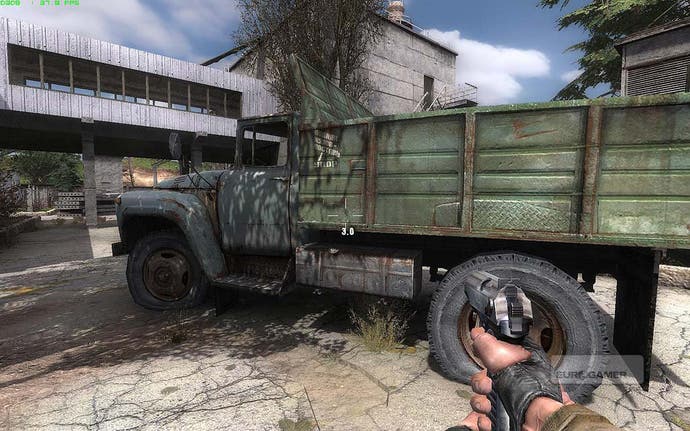Retrospective: S.T.A.L.K.E.R.: Shadow of Chernobyl
Not that kind of rad.
Merge this system with a world that was relatively free to explore, and you had a kind of open-world FPS that we really hadn't seen much of before that time. There were elements of RPGs too, with quests scattered across the landscape, and decisions about alignments with various Stalker factions to be made. Most crucial of all, there was the simple moment-to-moment challenge of staying alive in a predatory and aggressive world. If the radiation poisoning didn't get you, then the monstrous packs of dogs probably would. Here was a game that put the focus more on combat than simply on survival, and it was all the more thrilling for that.
The balance between a linear story and an "open" world was interesting in itself. Stalker's levels are interlinked, but not in themselves all that large. It never fully broke out into an open world, but was instead a sort of "wider" world. Rather than Fallout 3's sprawl, Shadow of Chernobyl, spatially, consisted in a series of discrete packages. Many of these feel like single FPS levels on their own. Indeed, the game often treats them in that way, with scripted events dropped into your path on a regular basis. Attacks by the military, an careful ambush, attacks by mutants, battles between the various paramilitary factions: all these came together in a patchwork of events, between which you wandered, finding the safe path in your own way.
This, I think, could be important as a model for open-world gaming, precisely because it doesn't follow the GTA route. Instead of simply allowing you to ramble around in a single, wide-open space, Stalker's explorations are much more directed. The various regions act as single, open-plan but linear FPS levels the first time they are played, but can be returned to later on. This means they're ultimately non-linear: there's a central hub location in which you can patch yourself up, drink, trade, and so on, and this creates reasons to return to previous areas, reasons to root around in the world beyond those provided by the core storyline. The constantly spawning and overlapping AI, meanwhile, means that things in the world continue to provide challenge. More often than not, a fight has started before you're even on the scene, as neutral, friendly and hostile forces encounter each other out in the wilderness, and slug it out under trouble skies.
Of course, there's another aspect at play in any retrospective look at a game like this. Time does funny things to PC games. It's arguable that despite everything that the GSC team and their THQ producers achieved, it was the mod community that finally burnished the weird metal of Shadow of Chernobyl to its current shine. Some of the changes that mod makers have made, such as "injured" state for the player, or the sleep function (in which the game plays little "dream" clips) are actually just unlocks of existing code, apparently dropped at the last minute. Presumably these decisions were made to avoid overwhelming shooter players used to rather less sophistication in their game, but then again perhaps they just didn't seem to sit right with the action game Shadow of Chernobyl ended up being. Whatever the truth, when unlocked by modders they give us a lot more game to be going on with.

The other rather more significant change that modders have made has been to the balance of combat. Many players noted that enemies didn't seem to go down easily enough, taking more than a couple of shots to the head with weaker weapons. Such balance issues have been addressed, and it's now possible to play the game tweaked to rather different expectations of weapon physics.
Most impressive of all is that it's now also possible to play Shadow of Chernobyl with an entirely overhauled texture set, which can be found online. As mods go this is one of the most subtle imaginable. It does not attempt to change the atmosphere or effect of the game world, but simple to enhance it. 900 new textures, an improved sky and weather system, and the introduction of expanded graphics options make this one of the most exquisitely beautiful experiences ever to grace a gaming system. It also includes the sleep and hunger systems, along with a mass of small tweaks. I would argue that this is, finally, the finished and complete version of Stalker - as good as it could possibly have been on release.
Stalker didn't manage to be as multi-pronged as something like Deus Ex, nor as all-encompassing and variable as something like Fallout 3. It will always sit in the second row in any parade of classics, but it is nevertheless a masterpiece. A cold, unearthly thing, which only a certain kind of gamer will ever love. If you have even the slightest interest in This Sort Of Thing, you owe yourself a trip to the zone.








